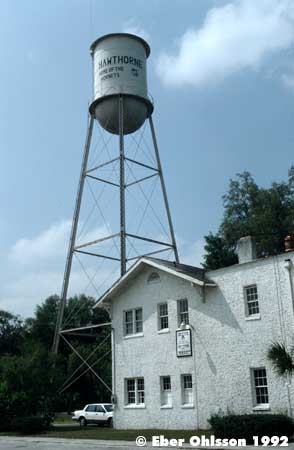Vattenstänk, house magazine of VA-verket Malmö [Water and Sewerage Works of Malmö] had a series short stories under the headline “During the holidays I saw …“, there all stories should illustrate something within the water field.
Dizzy journey
Published in the house magazine Vattenstänk 91 (1996-07-08).
by Eber Ohlsson
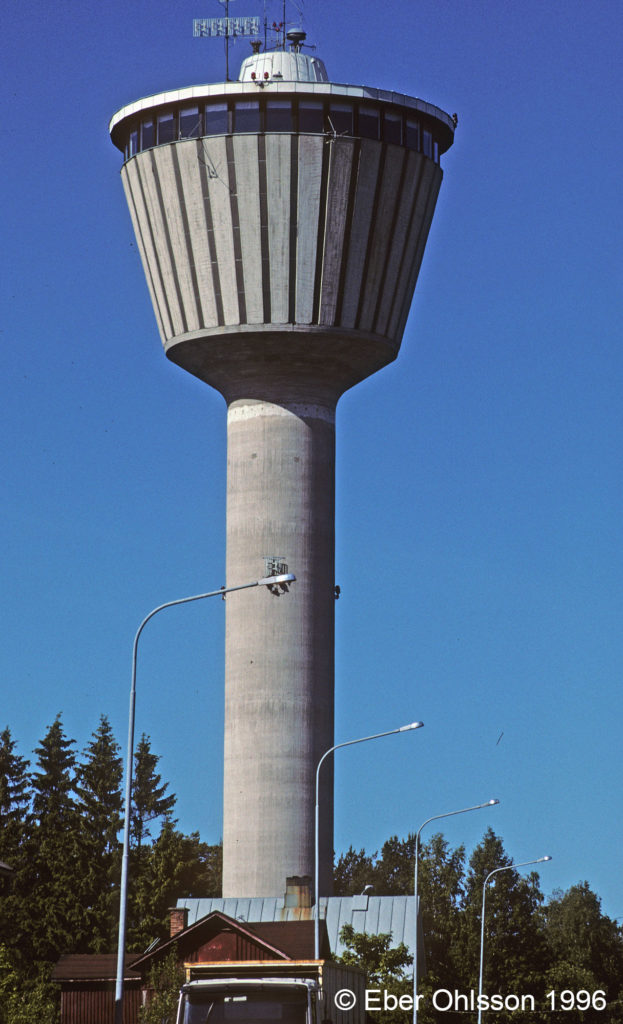
The Swedish original headline is “Hissnande färd”, “Hissnande”=dizzy, and “hiss”=elevator.
A free translation to English:
Wednesday the 26th of June I visited Nykarleby, Österbotten, Finland. A town with ca 8 000 inhabitants and there more than 90 % is Swedish-speaking. To get a good survey of the town, was the water tower visited, with their Café Panorama (in Finland is there many water towers with belvedere- and café-business). When I ride the elevator up to the top level of the tower, I’ve got at the same time a 46 meter art experience. Behind the wrought-iron door on the fourth side of the elevator become the journey quite astronomic. From the bottom level with its deep ocean picture to the outlook level with it’s starry sky.
The wall-painting was manifesting itself as the highest wall-painting in Finland. And quite new. The title was “Per aspera ad astra” and the artists were Peter Domlin and Ann-Christin Krooks. The innovator and the café proprietor was Kaj Wikblom. A young man that already had run the business in 12 years.
Interesting was not only the art experience, but even that Vattenstänk was the first journal on the spot. It was two days before the opening of the exhibition and the inviting press, including Expressen [a Swedish newspaper].
Negotiable bilingualism
Published in the house magazine Vattenstänk 93 (1996-08-01).
by Eber Ohlsson
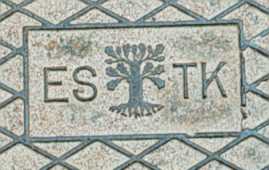

The Swedish headline is “Gångbar tvåspråkighet”, there the word “Gångbar” means both negotiable and that it is possibly to walk on.
A free translation to English:
In Vattenstänk no 90 I wrote about manhole covers that was still lying in spite of change of state and language (Tondern/Tønder). Two languages in one state you can find diametrically opposed in Scandinavia, in Finland. In the southern Finland is the town Ekenäs situated, a town name that the Swedish-speaking majority of the citizen is using. To the Finnish-speaking minority is the name of the town Tammisaari (which is a direct translation of the word Ekenäs).
On some of the manhole covers (see picture) is therefore the arm of the town, the oak, flanked of the abridgements “ES” respective “TK”. These abridgements shall be translated Ekenäs Stad respective Tammisaari Kaupunki. In areas in Finland that is bilingual, is the signposting rules that the majority language is standing on top/first. When you therefore look at a manhole cover (see picture) in Vasa and can see that “Vaasa” is standing on the top, you know that the town has a Finnish-speaking majority.
Ghost towers
Published in the house magazine Vattenstänk 94 (1996-08-09).
by Eber Ohlsson

An explanation to the last line is that in one of the water towers in Malmö work a person that many of staff believed as very unpleasant figure.
A free translation to English:
To some people is it a pleasure to visit water towers. In Helsinki [Helsingfors] is there a great number of this category. One explanation can be that the amusement park in the city is situated by the two water towers on he hill Åshöjden.
The amusement activities surround one of the towers, built 1938 and contain 16 000 m³ water. One of activities is a mini-train with one child in each vehicle that goes round the reservoir on rail. Another activity is the ghost train “Indiana’s Adventure” that that goes in the reservoir’s ground floor (look at the picture).
As a curiosity, can be said, that the other reservoir is situated close until the Lenin Park. Even if the Helsinki water tower in that reference is interesting, is there other water towers more closely to us there it is possible to meet unpleasant figures, without any suggestion of an enjoyment.
Take aim for manhole covers
Published in the house magazine Vattenstänk 95 (1996-08-28).
by Eber Ohlsson
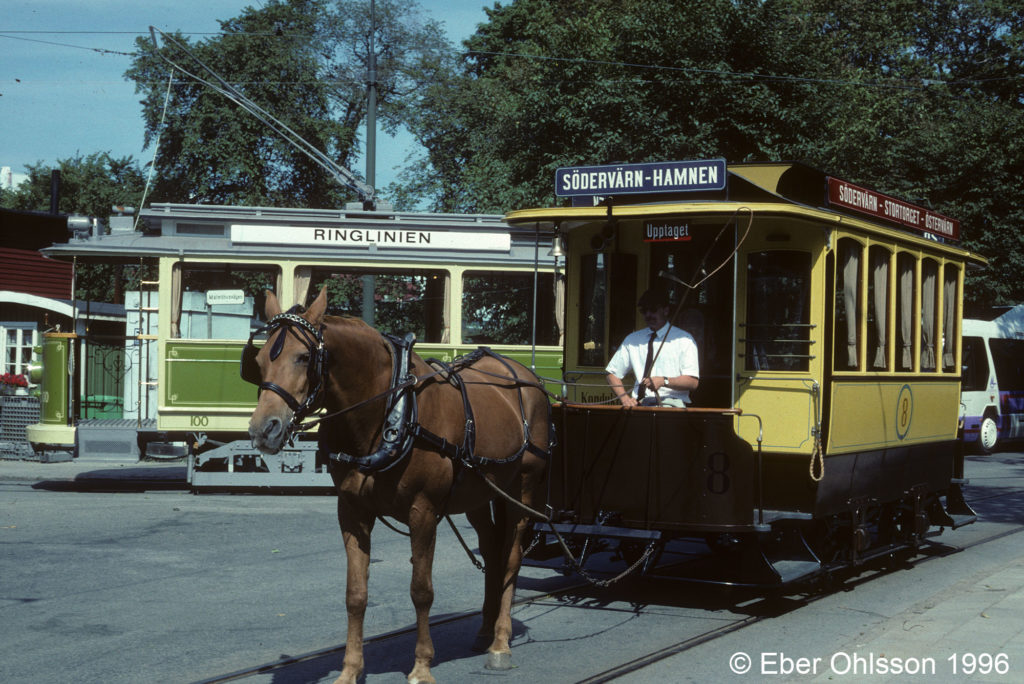
The writer was brakesman on the horse tram.
A free translation to English:
The weekend 10-11th August in this year [1996] was the anniversary of 90 years electric tram in Malmö celebrated. In the anniversary arrangement was one part evens the 109 years old horse tram car, that normally standing indoor the Technical Museum but now come out for a breath air. The tram car was wheeling on the tram rail in the Malmöhus road and the Kung Oscars road. As traction force was a 22 years old mare used.
Now is there not only tram rail in these both roads. There are also manhole covers, of which some of them are situated between the rails. Manhole covers that have another friction than asphalt, which even the old mare noticed. After have slip on a manhole cover, she careful took aim of the steps when she henceforth should pass a manhole cover, and studiously avoids treading on them.
Teach an old dog new tricks is probably difficult, but teach an old horse to be interested of manhole covers is on the other hand easy, which the brakesman can verify.
Solid societies
Published in the house magazine Vattenstänk 106 (1997-01-17).
by Eber Ohlsson

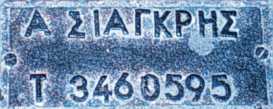
The Swedish prime minister Göran Persson [1996] made a statement in China when he was there on a state visit. The statement was the importance of a solid society, hint to China, a statement that the prime minister was criticized in Sweden.
A free translation to English:
It has the last time been a discussion about solid societies. The island Naxos in Greece ought to be a solid society, if you can measure a stability in manhole covers. Our earlier colleague Göran Lundström, that nowadays [1997] work at Sydvatten, has sent us a picture on a manhole cover from this island. Göran took a picture of a manhole cover under his vacation the last summer. On the manhole cover we can read (the translation is done by Jean Papoutsas, Sjölundaverket [a colleague from Greece that is working at one of our works]):
Hitirio (the name of the foundry)
A.Siagkris (the name of the founder)
T3460595 (telephone number)
A society there the telephone number is casting in the manhole cover, must be a society there they regard that a great many shall be permanent, a solid society.
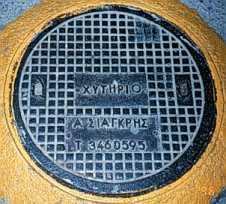

Foucault’s pendulum
Published in the house magazine Vattenstänk 124 (1997-10-13).
by Eber Ohlsson
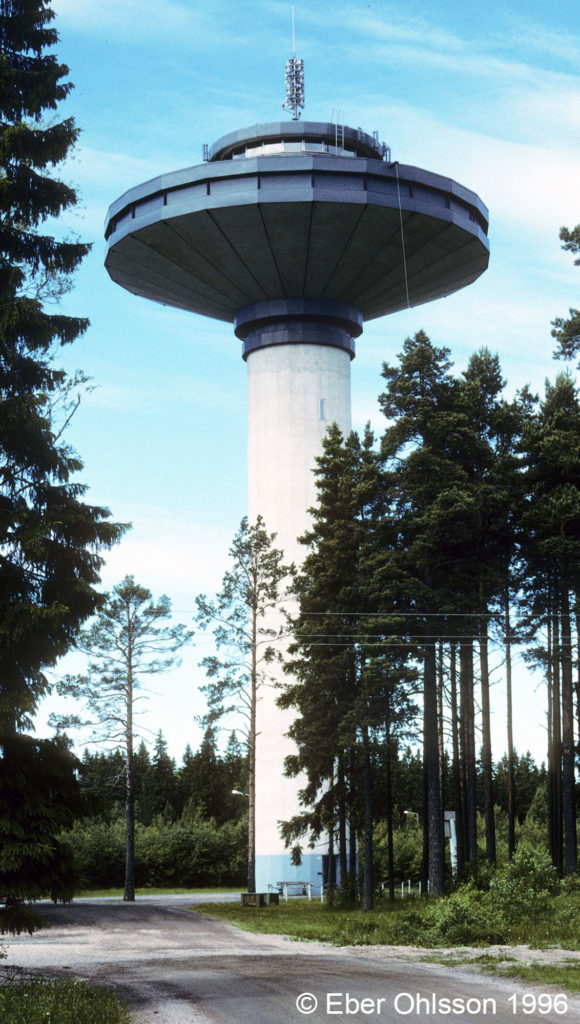
Finland is a bilingual country. Euraojoki, Rauma, Pori is Finnish – Euraåminne, Raumo, Björneborg is Swedish.
A free translation to English:
Foucault’s pendulum is one way to make clear the Earth’s rotating. If a pendulum start move will the pendulum according to the law of inertia continue to move in the same direction. The Earth’s rotating lead however to that the pendulum seemingly is change direction.
To see this phenomenon clearly and distinctly, must the pendulum be long. It takes time on that occasion before the pendulum stop, which in turn will do that you can see the change of the move.
The pendulum may not be disturbed by outer influence; therefore will normally such efforts take place indoor. As it happen when the French physicist Jean Bernard Léon Foucault the first time present this experiment in Pantheon in Paris 1851.
Say what not water towers can be used to. In the Finnish place Eurajoki/Euraåminne, between Rauma/Raumo and Pori/Björneborg is a water tower standing on a well-forested ridge. In the corbelling edge of the water tower is the pendulum fastens.
On the ground under is an area enclosure, so that the pendulum will be able to move protected. Moreover is there a sign that explain how the experiment works. The question is how often the pendulum is working. Probably: On and off.
Now has the experiment Foucault’s pendulum been done at closer quarters. The Astronomic Society Tycho Brahe [Malmö] has done such experiment in the Oxie water tower. That is it well suitable to, because there is a free space from the point of attachment until that the pendulum nearly touch the floor.
On the floor is a coloured tape strip paste, thereafter is the pendulum released in direction of the tape strip. After a while has the pendulum move been changed some degrees.
It should be interesting if the experiment could be repeated sometime with the staff of the Malmö Water Works. If enough long time has gone, should it be possible to see if there is any motion.


Empires and manhole covers
Published in the house magazine Vattenstänk 128 (1997-11-27).
by Eber Ohlsson
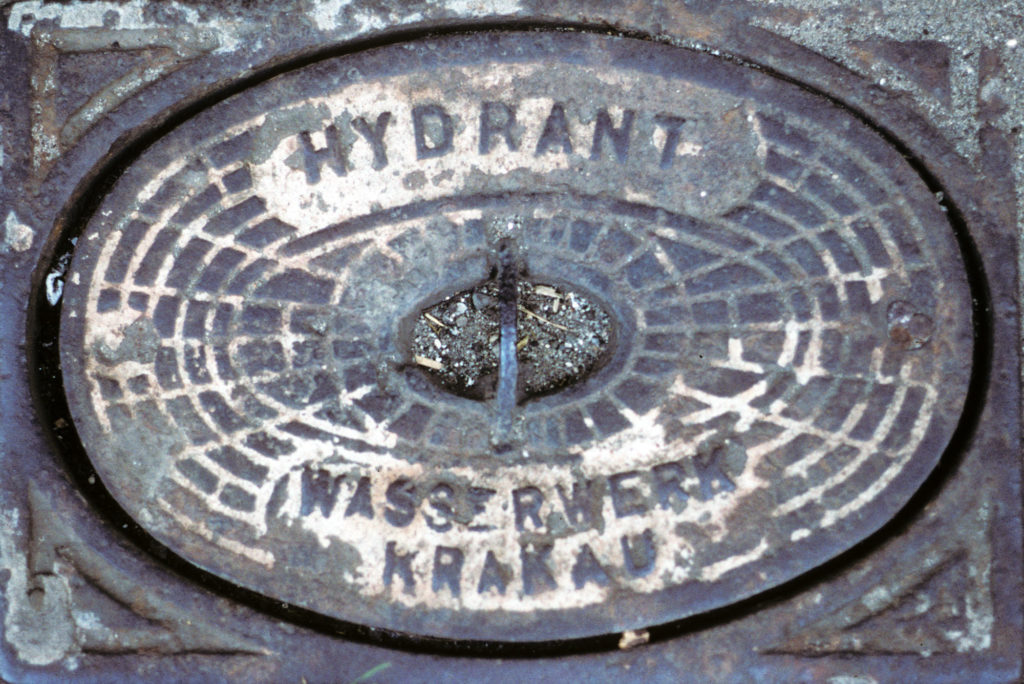
The last line is a play with words. The Swedish expression “gå under” mean among others “fall” and “walking under”. The expression “gå över” mean among others “walking over”.
A free translation to English:
Artefacts of the water supply in old empires are something that sometimes is discovered. The first thoughts go to the Roman Empire, but there are even other empires that have fall, and left marks of there’s water supply.
In the south Poland is the old civilized city Krakow situated. At a shady side street found the writer 1992 a manhole cover with the text “Hydrant Wasserwerk Krakau” (see picture). The German text shows that the city once was a part of the Austro-Hungarian Empire (until 1918). In an excursion westbound to the nearby Silesia, was the earlier Corner of Three Empires [3Kaiserreichecke] passed, a three country cairn there the German, the Russian and the Austro-Hungarian Empires was meeting. In this old border corner where there no visible traces from this greatness time.
Contrary to old border marks and street signs is the old manhole covers still there. The empires may fall [gå under] but you can all time walking over [gå över] there’s man hole cover.
Karl Marx and Chemnitz
Published in the house magazine Vattenstänk 129 (1997-12-03).
by Eber Ohlsson
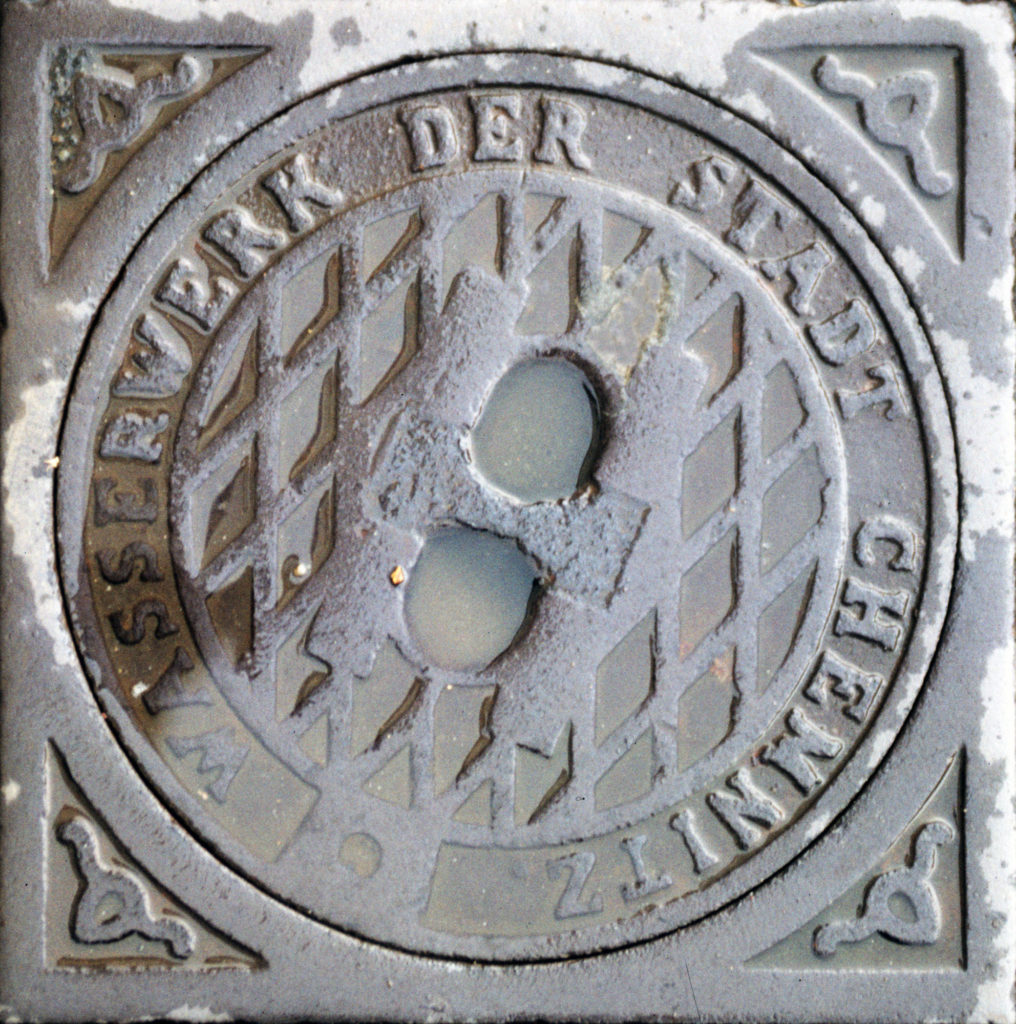
A free translation to English:
In the house magazine Vattenstänk no 128 we write that political system may be changing, but the man-hole covers is still lying. Another example of this is the city of Chemnitz in Saxony, East Germany. The city changed name under the DDR’s time to Karl-Marx-Stadt (Karl Marx had no connection to the city). But even so late as 1983 and 1990 was it possible among others to find manhole covers outdoor the city hall there the name of the city was Chemnitz. After the reunification of Germany, get the city back the old city name Chemnitz. And direct had the manhole covers the right name. For the benefit of citizens in the city and there’s economy.
Water power
Published in the house magazine Vattenstänk 130 (1997-12-15).
by Eber Ohlsson

A free translation to English:
We [Malmö Water Works] supply water with pressure, but there is in the history example; there pressure has been supplied by water. Water has at that time not been the product but the medium. That was the case in London in the 1800s. A metropolis, there it was many facilities that demands power like for example elevators and cranes. If the power not was produced at the locality, must it be some state of power supply in the city. Seeing that the electricity power not was present at this time, the power was distribute in shape of water pressure (circa 28 bars).
A company, London Hydraulic Power (LHP) was founded, that commercial supplied for this service. Even in this supply system must it be able to control, with that following manhole and manhole covers. Therefore can you in London see manhole covers with the text LHP (picture). In the middle of 1970s, after circa 100 years operation was it closed down. The electricity had been a better distributing form. Now has the main system, in today’s fibre optical and digital world, come upon a new and none the less commercial field of application.
Light plate
Published in the house magazine Vattenstänk 131 (1998-01-13).
by Eber Ohlsson

A free translation to English:
The Hyllie water tower has now got an illumination that is superb. It is a lift to the tower (but not to the pressure). Now we only lack a bonze plate, there we tell to whom we dedicate the tower illuminating, if we shall apply the same principle, as in “the Swedish town” Kingsburg in California, USA (picture). The question is only to whom, that has given such outstanding contribution to city of Malmö that it shall be apostrophe. Perhaps someone that has throw light on one conditions and another in the city.
What concern the water tower in Kingsburg, is this a great deal smaller, and has a very special shape and painting. We will describe this tower at another opportunity.
Tower design
Published in the house magazine Vattenstänk 132 (1998-01-26).
by Eber Ohlsson
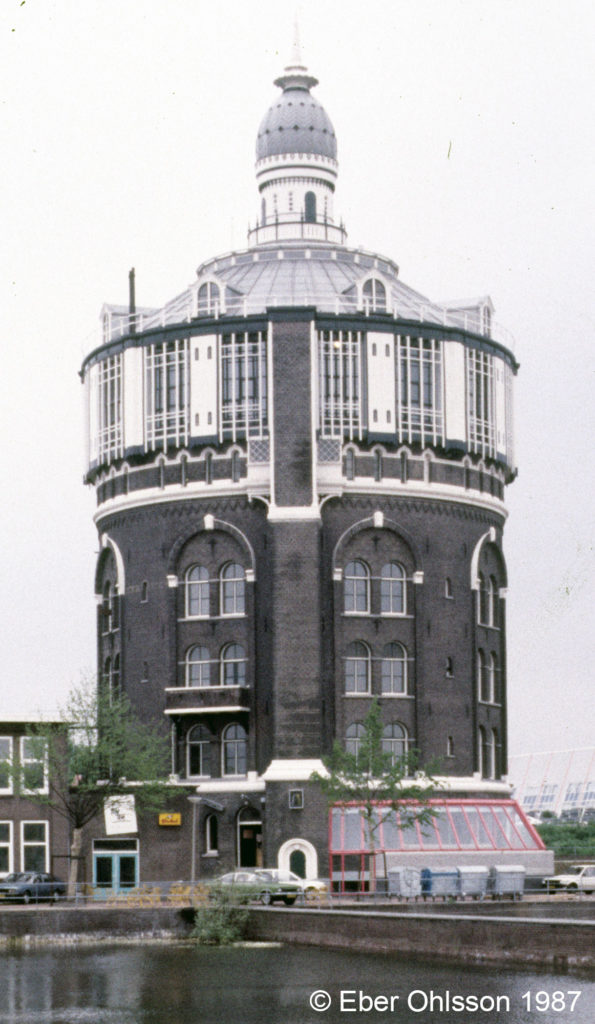
A text in connection with a television production in Hyllie water tower, there the belvedere was shaped as an architect’s office.
A free translation to English:
Architect’s office in water towers not only exists in the world of television and movies. These creative surroundings exist even in the reality world, as in Rotterdam. The water tower in the old water works area is standing in such surroundings situated beside the river Nieuwe Maas and upstream the city centre.
The sign at the entrance expose this creative direction. The firm Landmark Design & Consult has also the water tower as a logo. In the area is there not only the water tower (Watertoren in Dutch) that is preserved, but even the other water work buildings, and a part of filter reservoirs. The 125 years old water in an eclectic architecture can therefore henceforth reflect itself in the water.


Stadt im Quadrat
Published in the house magazine Vattenstänk 133 (1998-02-02).
by Eber Ohlsson
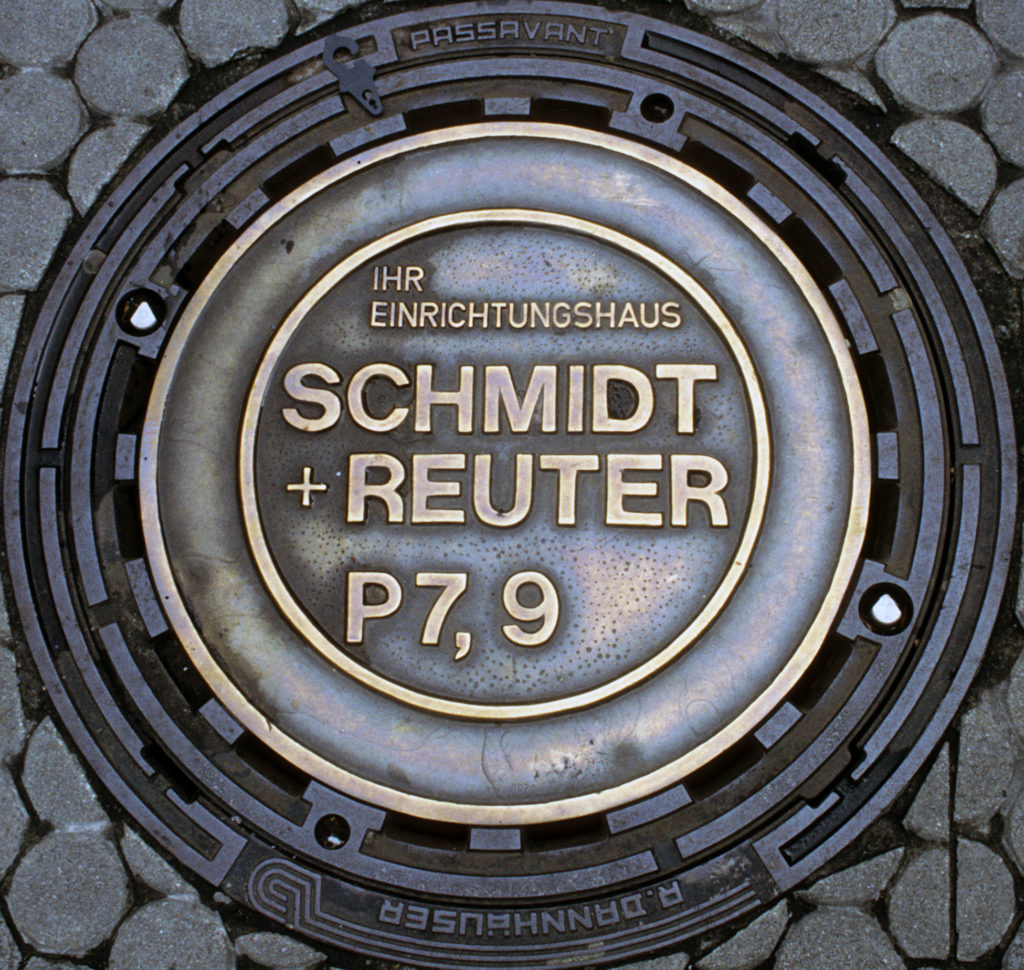
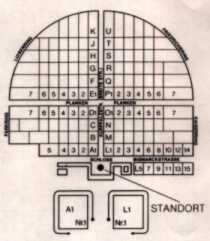
A free translation to English:
A text at a manhole cover, state usual information about the pipe that it is connected to. But there are exceptions. The manhole cover at the picture from Mannheim, a city in Baden-Württemberg, Germany, shows that. The manhole cover is double interesting.
At the first: It is an advertising manhole cover. In many cities in Germany, you can find manhole covers, there the local firm advertises for its products or services. In Mannheim is there at the given address, a house with decoration/furniture, Schmidt+Reuter.
At the second: The street address (P7,9) differs from the normal. Mannheim has as you see a very special address form. The once strongly fortified and circular city, on a neck of land between the rivers Neckar and Rhine, is divided in four quadrants.
The two axles that cross each other, and which divide the city, is the only that have a street name. All blocks, strict quadratic, has one letter and one numerical term according to a certain pattern (A1-U6). Numbering of the houses go on by blocks, east of the axle clockwise, west of the axle anticlockwise.
The address on the manhole cover can therefore, to the well-informed, be easy to find (close to the magnificent water tower). As a matter of fact is there a good reason why the city is called “Stadt im Quadrat”.
Double towers
Published in the house magazine Vattenstänk 134 (1998-02-17).
by Eber Ohlsson
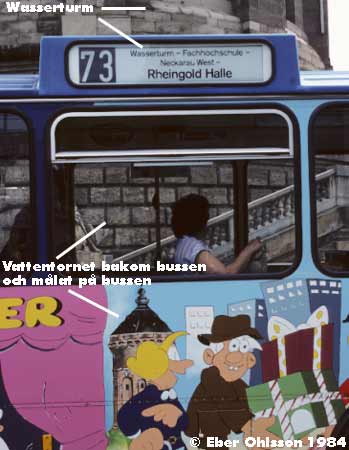
A free translation to English:
Water towers can be so popular, that they will be synonymous with its city. An example on this is the magnificent water tower in Mannheim. In the background on one of the large street axles (see Vattenstänk 133) is the water tower rising in its all splendour.
The year 1984 was one of the city’s buses photographed in front of the tower. It was the bus line no 73; there one of the terminuses was Wasserturm. A water tower so dominant, that the name of the bus stop is only Water tower.
The same water tower is reproduced on the bus, which gives the bus side the right local colour, so that all Mannheim citizens could recognize themselves. The water tower in the original shape can besides be seen behind the pane of the bus.
The tower is moreover included in the trademark, that Mannheim using in the marketing. The other part of the trademark is the square-city, mentioned in the last number of the Vattenstänk. The name on the marketing organisation in Mannheim has in same ways a similarity with the organisation in Malmö. The name is Magnet Mannheim.

Postscript.
The city of Malmö tried at this time to marketing itself as Magnet Malmö, which become a short and failure experiment.
Flying fish
Published in the house magazine Vattenstänk 137 (1998-03-20).
by Eber Ohlsson
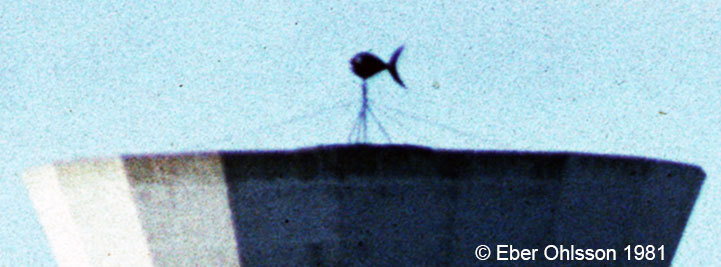
Bohuslän is region in Sweden. The fishing village Smögen on the Swedish west coast is an important port of landing shrimps.
A free translation to English:
Vanes is must benefit, when it’s windy. And windy is it often on the roof of the water towers. It is not a disadvantage if the vane has a local character, as on the water tower in Smögen in Bohuslän.
There adorn a metal fish the roof. A metal shrimp was else what you could expect. But the fish form is more practical to a vane. It can not be that the shrimp is too small and simple, if you thought on the incomes the shrimps gives Smögen. After all, we are gratefully that it is a water animal that adorn the water tower.

A pump at the top/Super pump
Published in the house magazine Vattenstänk 138 (1998-04-01).
by Eber Ohlsson

A free translation to English:
On the roof of the water tower on Buöy in Stavanger, Norway is there a vane that really connects to water supply. The vane illustrates pumping up water on the old fashion. What we today else associate with Stavanger, the oil capital of Norway, is of course oil pumping.
Arrow at Pildamm
Published in the house magazine Vattenstänk 140 (1998-04-28).
by Eber Ohlsson
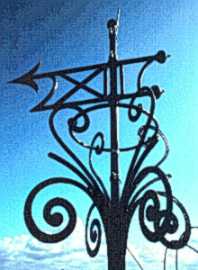
The Swedish word “Pil” means both “arrow” and “willow”; the word “damm” means reservoir.
A free translation to English:
The water tower at Pildammarna is the only water tower in Malmö that has a vane. The current architectural style when the tower was built was the Art Nouveau. Therefore must the windings that stand out against the heaven be judged as this style, a work of art that is exhibited every day. Malmö coat of arms, a griffin head (eagle), had perhaps also suit well, on the second oldest water tower of the city.
Eagle on a spire
Published in the house magazine Vattenstänk 142 (1998-05-18).
by Eber Ohlsson
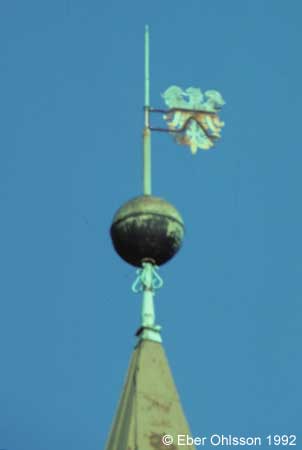

Värmland is a region in Sweden.
A free translation to English:
An eagle that not flies away, is sitting on the Säffle water tower. It is the heraldic eagle of Värmland that at the same time is the Säffle’s coat of arms. The vane includes not the bottom part of the town’s coat of arms. It makes of a blue field that symbolize the Säffle canal. It had otherwise been interesting if the water symbol was placed on the top of water tower. Else is Säffle associate with another drink – coffee [a well-known Swedish humour sketch].
Memory of a non-event
Published in the house magazine Vattenstänk 149 (1999-03-09).
by Eber Ohlsson
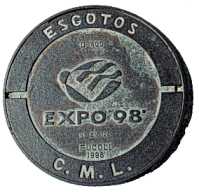
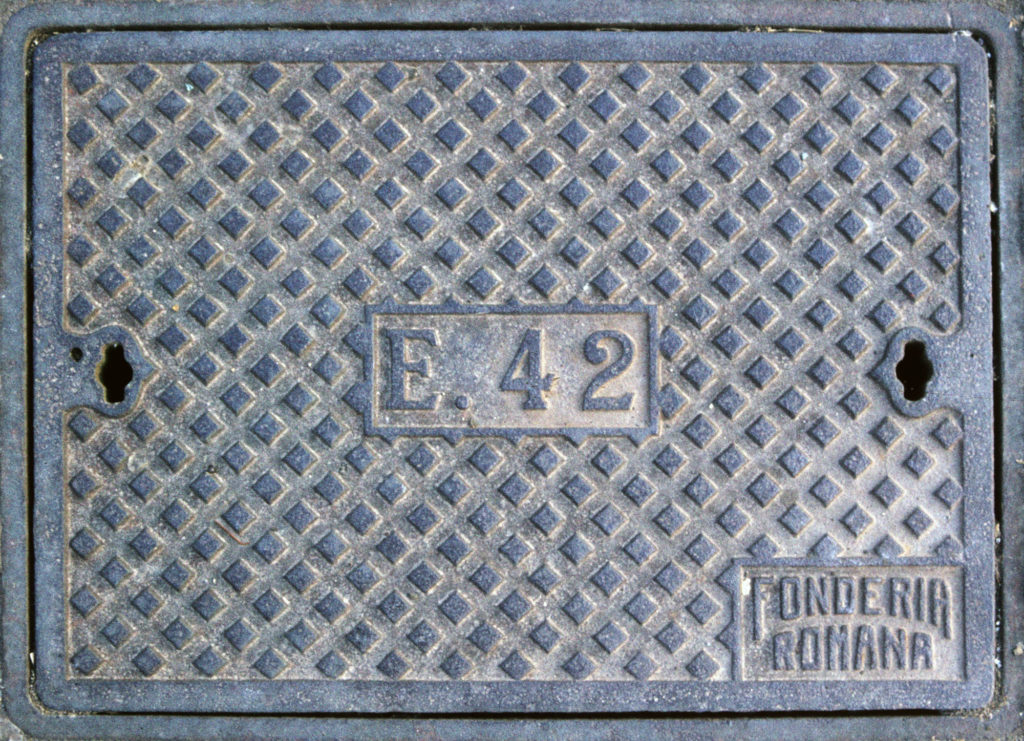
A free translation to English:
The summer 1998 was there held a world exhibition in Lisbon, Expo’98, with the ocean as theme. Like other world exhibitions will some building be standing left as a memory from the event, as the Eiffel tower at the Paris exhibition 1889. It is not only buildings that will be memories of what has taken place, even things down-to-earth as manhole covers will often still be there after the end of the celebration.
That will certainly be the consequence with the special casting covers that there were at the Expo’98 in Lisbon. These covers will point on an event that has taken place, but there are examples of still lying manehole covers from a world exhibition that never took place, as in Rome. In this Italian metropolis is there a suburb south the city that is called EUR. It is an acronym for Esposizone Universale di Roma. It was originally built to a world exhibition that was planned to take place 1942.
Of course was it impossible just while the world war was to realize the exhibition. But that circumstance that the exhibition never comes brought doesn’t mean that the area not was built. Therefore can you today, in the EUR find manhole covers that have the notation “E.42”, and with that be reminding of something that never has taken place.
An emergency solution
Published in the house magazine Vattenstänk 151 (1999-03-29).
by Eber Ohlsson

The Swedish expression “full rulle” is double-edged and means both “going like a house on fire” and “complete roll”.
The Swedish expression “ärlighet varar längst” can be translated as “honestly is the best policy” but the direct translation will be “honestly will last longest”.
A free translation to English:
Periodically can it probably /be going like a house on fire/be complete roll/ on the public motorway convenience on Farø in Denmark, even if it not was the case when the picture was taken 1990.
Eight rolls of toilet paper, there every toilet roll axle is equipped with a padlock, can either indicate that the needs is very large in Denmark (the food can be one factor) or that the supervision is less frequent and this in the combination with that the authorities think at the men’s darker side.
If now not the honestly will last longest will at least the papers do it.
Arrow at empty
Published in the house magazine Vattenstänk 155 (1999-06-18).
by Eber Ohlsson
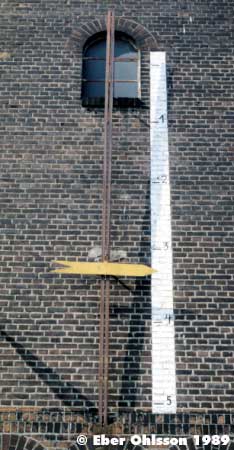
The Swedish word “pil”means both “arrow” and “willow”, and the word “tomt” means both “empty” and “garden”. The headline could also be “Willow in a garden”.
A free translation to English:
To serve the citizens with water at the best way, demand that the water works has knowledge where they have the water resources, for example the resources they have in the water towers. One simple method to get knowledge about the quantities is to measure the water level with float.
This information shall then be transported to there it will be need. Today will the transport be done in an electronic form to the supervision central at the water works.
An easier way, if the information only shall be transmitted to the outside of the water tower, is a direct connection to the float. The water tower in Lehrte (east of Hanover) in Lower Saxony, Germany visualize this way.
Here is a metal arrow fasten in a wire that raise and fall along a guide and point at the same time on a scale, graduate so the arrow is at the highest point when the reservoir is empty. If the water tower is within sight of the supervisor is it only to look at the water tower, possible with help of binoculars.
An information technology that is safe even at the millennium shifts.
Run on water
Published in the house magazine Vattenstänk 156 (1999-07-22).
by Eber Ohlsson
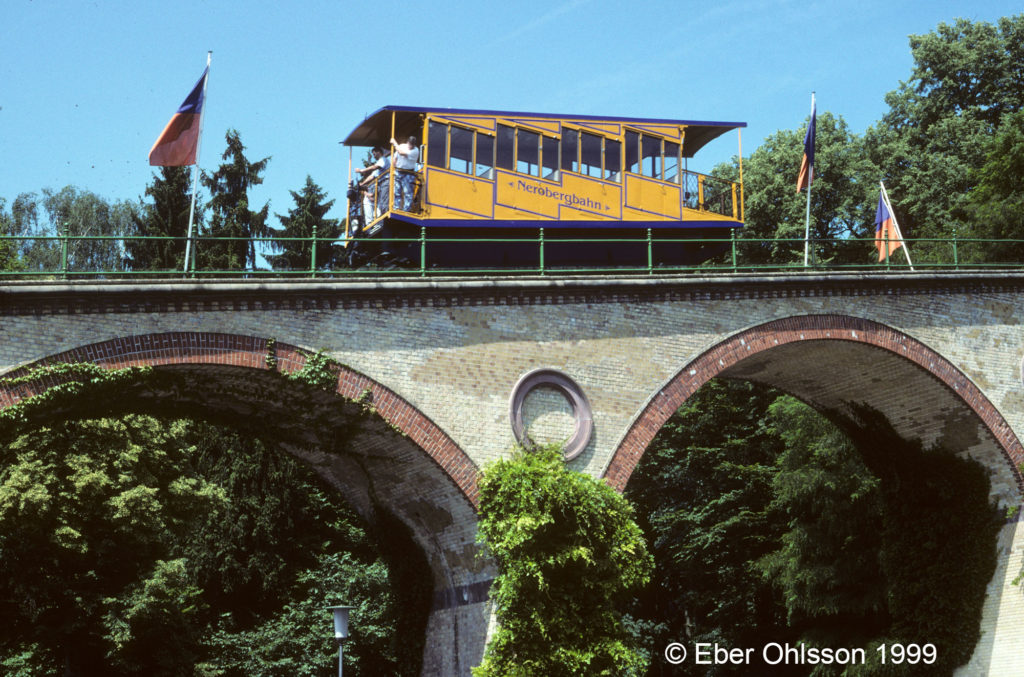
The Swedish word “gå” can even mean “walking”.
A free translation to English:
Water can give energy. Water energy that is transformed to electricity can for example move tram cars. But even only usually water can give tram cars kinetic energy, as in Wiesbaden in Germany.
In the north-western part of this city is the Neroberg situated, 245 meter above the ocean, and with a number of interesting things worth to seeing. One way to reach these is to take the funicular. A tramway runs on water.
The 438 metres long funicular has, as other funiculars two corresponding vehicles. That is wires that see to that when one of vehicles is in the lower location will automatically always the other vehicle be in the upper location, and the vehicles will be meeting in the middle of the track.
The special with the funicular at the Neroberg is that it operates with water. Under the respective vehicle is there a tank that contains 7 000 litres water. When the vehicle is in the upper location will the tank be filling with water.
Under the travel down is the task for the driver to break the vehicle, so that travel not goes to fast. When the vehicle reach the lower location will the emptying valves automatically be opened and all water flow out the vehicle.
A possible scenario would to use a naturally stream or the surface water. Under its way down to the recipient should this water be use to force a tram car. But in Neroberg was the track ecocycle adapted already when it starts 1888. The water that is empties in the lower location, run down in a reservoir and is pumped up to the reservoir at the upper station.
The track is only in operation under the period April-October, which can be intelligible, because there are complications when the water has a solid form, which not is unusual under the winter.

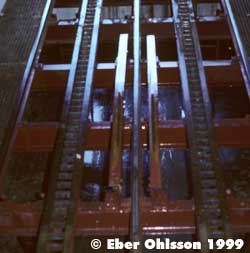
The Home of the Hornets
Published 2000-05-20.
by Eber Ohlsson
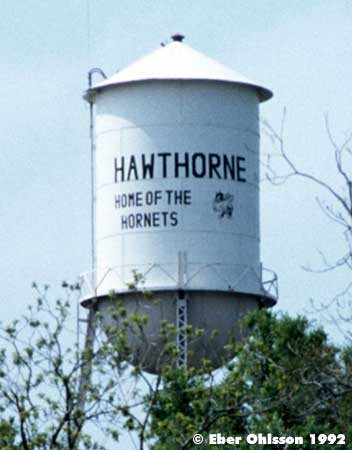
A free translation to English:
On a journey from Tampa on the west coast of Florida to oldest city in USA Saint Augustine on the east coast of Florida, was a small place – Hawthorne passed. The place had a small water tower in steel, and in usual American tradition was the name of the place painted on the tower.
The text was “Hawthorne – Home of the Hornets”. The text does you watchful. Not only has the Florida a lot of venomous snakes and alligators, to land in the home of the hornets doesn’t do it more pleasant.
The next thought that hit you, was that the US Navy’s aircraft F-18 has the name Hornet. Were there any military airports nearby? No, in the area were there no such airports at least no that were marked at the map.
And even if the inland of Florida is very water rich, is it not water for the aircraft carrier of the US Navy. The next question becomes which aircraft manufacturer that had manufactured F-18? Could it be Northrop Corporation?
Back to Scania could set of volumes confirm the information that it was Northrop and that the factory was situated in Los Angeles. On the city map over this urban agglomeration you can find the name Hawthorne. South of Hawthorne Municipal Airport has you Northrop Avenue.
The plausible explanation could be that Hawthorne in Florida is pride of there’s namesake in California. Later information has given a more simple explanation of the water tower text. The Hornets is the name of the local football team (American football). The explanation got after all a good touchdown.
The tower is now demolished (2010).
